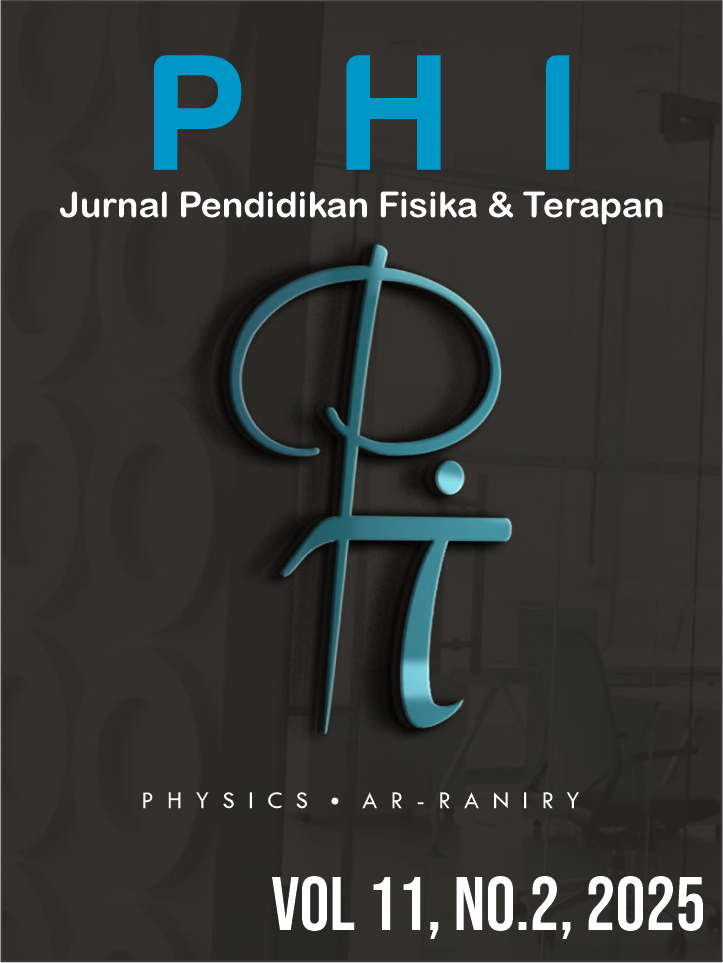Application Of Guided Inquiry Model To Improve The Ability And Critical Thinking Disposition Of Senior High School Students In Physics Learning
DOI:
https://doi.org/10.22373/6js5t958Keywords:
Guided Inquiry, Critical Thinking Ability, Critical Thinking DispositionAbstract
This study aims to examine the effectiveness of the Guided Inquiry model in improving students' critical thinking ability and disposition on alternative energy materials. The research design used a pseudo-experiment with a quantitative approach. The research subjects consisted of 70 X grade students who were divided into two groups, namely the experimental group (Guided Inquiry) and the control group (Problem-Based Learning). The results showed that the increase in CTA and CTD of the experimental class was significantly greater than the control. Critical thinking ability increased from 37.26 to 74.03, and critical thinking disposition from 54.00 to 67.89. T-test and effect size analysis showed significant differences and a large impact. There was a positive correlation between critical thinking skills and disposition (r = 0.483; p < 0.001). The Guided Inquiry model proved effective in developing students' overall critical thinking skills.References
Abrami, P. C., Bernard, R. M., Borokhovski, E., Waddington, D. I., Wade, C. A., & Persson, T. (2015). Strategies for teaching students to think critically: A meta-analysis. Review of Educational Research, 85(2), 275–314.
Ady, W. N., & Warliani, R. (2022). Analisis kesulitan belajar siswa sma terhadap mata pelajaran fisika pada materi gerak lurus beraturan. Jurnal Pendidikan Dan Ilmu Fisika, 2(1), 104–108.
Afriansyah, E. A., Herman, T., & Dahlan, J. A. (2021). Critical thinking skills in mathematics. Journal of Physics: Conference Series, 1778(1), 012013.
Alghadari, F. (2013). Pembelajaran berbasis masalah untuk meningkatkan kemampuan dan disposisi berpikir kritis matematik siswa SMA. Jurnal Penelitian Pendidikan, 13(2).
Antonio, R. P., & Prudente, M. S. (2023). Effects of Inquiry-Based Approaches on Students’ Higher-Order Thinking Skills in Science: A Meta-Analysis. International Journal of Education in Mathematics, Science and Technology, 12(1), 251–281. https://doi.org/10.46328/ijemst.3216
Arfianawati, S., Sudarmin, S., & Sumarni, W. (2016). MODEL PEMBELAJARAN KIMIA BERBASIS ETNOSAINS UNTUK MENINGKATKAN KEMAMPUAN BERPIKIR KRITIS SISWA. Jurnal Pengajaran Matematika Dan Ilmu Pengetahuan Alam, 21(1), 46–51. https://doi.org/10.18269/jpmipa.v21i1.36256
Arikunto, S. (2021). Dasar-dasar evaluasi pendidikan edisi 3. Bumi aksara.
Daly, W. M. (1998). Critical thinking as an outcome of nursing education. What is it? Why is it important to nursing practice? Journal of Advanced Nursing, 28(2), 323–331.
Ennis, R. (2011). Critical thinking: Reflection and perspective Part II. Inquiry: Critical Thinking across the Disciplines, 26(2), 5–19.
Fauzi, A. M., & Abidin, Z. (2019). Analisis keterampilan berpikir kritis tipe kepribadian thinking-feeling dalam menyelesaikan soal PISA. Suska Journal of Mathematics Education, 5(1), 1–8.
Fraenkel, E., & Meierhenrich, J. (2018). The dual state: a contribution to the theory of dictatorship. Oxford University Press.
Hasan, S. W., Auliah, A., & Herawati, N. (2020). Pengembangan Instrumen Penilaian Kemampuan Berpikir Kritis Siswa SMA. Chemistry Education Review (CER), 3(2), 185. https://doi.org/10.26858/cer.v3i2.13769
Irwanto, I., Suryani, E., & Cahyani, T. S. (2024). Improving Students’ Critical Thinking Skills Using Guided Inquiry with Problem-Solving Process. International Journal of Religion, 5(6), 243–251. https://doi.org/10.61707/917r2021
Johnson, R. B., & Christensen, L. B. (2024). Educational research: Quantitative, qualitative, and mixed approaches. Sage publications.
Lai, E. R. (2011). Critical thinking: A literature review. Pearson’s Research Reports, 6(1), 40–41.
Maknun, J. (2020). Implementation of Guided Inquiry Learning Model to Improve Understanding Physics Concepts and Critical Thinking Skill of Vocational High School Students. International Education Studies, 13(6), 117. https://doi.org/10.5539/ies.v13n6p117
Mappan, V. S., Tandililing, E., & Yani, A. (2020). Pengaruh Mnemonic Terhadap Daya Ingat dan Kemampuan Berpikir Kritis Mengenai Ukuran Dispersi Sebaran Data. Jurnal Pendidikan Dan Pembelajaran Khatulistiwa (JPPK), 9(7).
Maulidia, M., Dargusch, P., Ashworth, P., & Ardiansyah, F. (2019). Rethinking renewable energy targets and electricity sector reform in Indonesia: A private sector perspective. Renewable and Sustainable Energy Reviews, 101, 231–247.
Palavan, Ö. (2020). The effect of critical thinking education on the critical thinking skills and the critical thinking dispositions of preservice teachers. Educational Research and Reviews, 15(10), 606–627. https://doi.org/10.5897/ERR2020.4035
Penulis, P. (n.d.). Penerapan Model Pembelajaran Guided Inquiry Untuk Meningkatkan Keterampilan Proses Sains Siswa pada Materi Alat-Alat Optik Di SMA Negeri 11 Surabaya.
Rizky, E. N. F., & Sritresna, T. (2021). Peningkatan kemampuan berpikir kritis dan disposisi matematis siswa antara guided inquiry dan problem posing. PLUSMINUS: Jurnal Pendidikan Matematika, 1(1), 33–46.
Rogers, J., & Revesz, A. (2019). Experimental and quasi-experimental designs. In The Routledge handbook of research methods in applied linguistics (pp. 133–143). Routledge.
Ruhbani Amarulloh, R., & Asep Irvan Irvani, Mp. (2025). METODE PENELITIAN KUANTITATIF DALAM PENDIDIKAN: Sebuah Panduan Praktis. www.sigufi-publishing.com
Sutton, J., & Austin, Z. (2015). Qualitative research: Data collection, analysis, and management. The Canadian Journal of Hospital Pharmacy, 68(3), 226.
Syamsuddin, N. S., Rasyid, M. R., Tayeb, T., & Nur, F. (2024). Efektivitas Penerapan Model Pembelajaran REACT (Relating, Experiencing, Applying, Cooperating, Transferring) terhadap Kemampuan Pemecahan Masalah Matematika Peserta Didik. Al Asma: Journal of Islamic Education, 6(1), 66–78.
Verawati, N. N. S. P. (2013). Meningkatkan keterampilan proses sains mahasiswa melalui pengembangan program pembelajaran fisika menggunakan model inkuiri. Lensa: Jurnal Kependidikan Fisika, 1(2), 125–132.
Wenning, C. J. (2011). The levels of inquiry model of science teaching. Journal of Physics Teacher Education Online, 6(2), 9–16.
Yunarti, T. (2011). Pengaruh metode socrates terhadap kemampuan dan disposisi berpikir kritis matematis siswa SMA. Disertasi Tidak Diterbitkan. Bandung: UPI.
Downloads
Published
Issue
Section
License
Copyright (c) 2025 Agni Gina Maolani, Resti Warliani, Asep Irvan Irvani

This work is licensed under a Creative Commons Attribution-NonCommercial 4.0 International License.
Authors who publish with Jurnal Phi agree to the following terms:
- Authors retain copyright and grant the journal right of first publication with the work simultaneously licensed under a Creative Commons Attribution License (CC BY 4.0) that allows others to share the work with an acknowledgment of the work's authorship and initial publication in this journal.
- Authors are able to enter into separate, additional contractual arrangements for the non-exclusive distribution of the journal's published version of the work (e.g., post it to an institutional repository or publish it in a book), with an acknowledgment of its initial publication in this journal.
- Authors are permitted and encouraged to post their work online (e.g., in institutional repositories or on their website) prior to and during the submission process, as it can lead to productive exchanges, as well as earlier and greater citation of published work (See The Effect of Open Access).

















